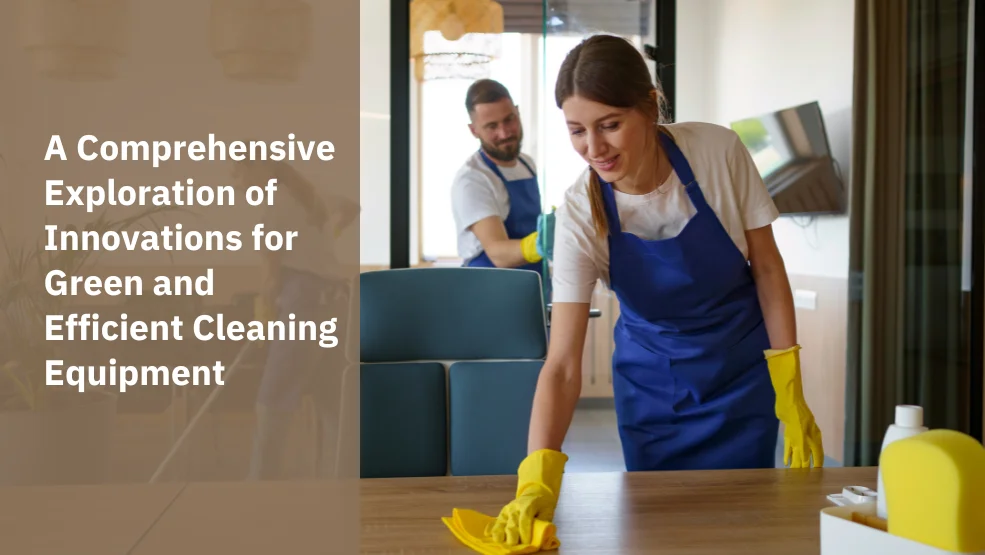The cleaning industry is undergoing a radical transformation driven by the demand for greener products, social responsibility standards, and a commitment to sustainability. Governments enforce stricter regulations, leaving businesses with no choice but to adapt or potentially face steep penalties. In this blog, we’ll explore the latest trends and innovations in green and efficient cleaning. Let’s get started.
Advanced Formulations
A wave of innovation is washing over the cleaning industry as manufacturers shift their focus towards developing eco-friendly solutions. They’re crafting advanced formulations and environmentally friendly ingredients while ensuring performance matches that of traditional cleaners. But the question remains: how can manufacturers push the envelope even further, elevating performance while staying firmly rooted in environmental responsibility?
To unlock the full potential of green cleaning, manufacturers must fuel the research and development engine. They can continue to hunt for powerful, biodegradable, plant-based ingredients that outshine their traditional counterparts. Partnering with academic minds and cross-industry collaborators will ignite innovation, propelling green cleaning to new heights of performance and efficiency.
Enzyme-based cleaners
Enzyme-based cleaners are taking over commercial cleaning. These powerful cleaners are winning hearts (and surfaces) by harnessing the natural power of enzymes to break down dirt at its core. But are they a one-size-fits-all solution?
Not quite. While enzyme-based cleaners perform well against organic invaders like food spills, pet stains, and bathroom grime, they may not be effective against mineral deposits or heavy grease.
When dealing with organic matter and stains, enzyme-based cleaners really shine. They’re non-toxic, biodegradable, and sustainable, leaving you with sparkling results and a clean conscience. Remember, enzyme-based cleaners will not work for everything; you may need to use a different product for other cleaning challenges.
Nanotechnology
Nanotechnology is scrubbing its way into the cleaning industry. Researchers are working on developing nanoparticles that can remove dirt and grime without the use of harsh chemicals. This innovation promises to remove dirt and grime from surfaces while reducing the planet’s carbon footprint. But how soon will this innovation hit our doors? Researchers claim it may take up to 5–10 years as more research is conducted and the technology becomes more accessible and affordable. However, this timeline could be influenced by regulatory approvals and public acceptance of nanotechnology-based cleaning products.
IoT and automation
Incorporating IoT (Internet of Things) technology and automation in the commercial cleaning sector promises to enhance operational efficiency and optimize resource utilization. Intelligent cleaning devices with IoT capabilities help you identify dirt and grime levels, facilitating targeted cleaning and reducing the need for water and cleaning product consumption. By leveraging IoT and automation, businesses can achieve cost savings, time efficiency, and resource optimization, contributing to a more sustainable and environmentally friendly operation.
So, what challenges and obstacles might arise in implementing IoT and automation within the commercial cleaning industry? Well, The potential challenges and barriers associated with implementing IoT and automation in the commercial cleaning sector encompass the substantial initial costs linked to the installation of smart devices and automated machinery. There are also concerns regarding cybersecurity, resistance from the workforce towards adopting new technologies, and the necessity to update or integrate existing infrastructure and processes to accommodate the introduction of novel technologies.
Water-saving technologies
As the global issue of water scarcity continues to escalate, businesses are actively seeking methods to reduce water consumption in their cleaning operations. Innovations in water-saving technologies, exemplified by low-flow cleaning systems and waterless cleaning products, play a pivotal role in curtailing water consumption within the realm of commercial cleaning. The integration of water-saving technologies is imperative for ensuring the long-term sustainability of the retail cleaning industry.
To effectively balance water conservation with maintaining high cleanliness standards, businesses can embrace water-saving technologies, including low-flow and waterless cleaning systems. Additionally, implementing efficient cleaning schedules that minimize water waste proves instrumental. Furthermore, providing staff training on water conservation techniques and ensuring regular equipment maintenance is essential to guarantee optimal cleanliness while concurrently conserving water.
Green Cleaning Certification
Green certifications, exemplified by entities like Green Seal and EcoLogo, are gaining prominence as businesses and consumers seek third-party validation of the environmental friendliness of cleaning products and services. These certifications foster ongoing enhancements in the green cleaning sector, fostering consumer trust through transparency and credibility, thereby promoting the broader adoption of sustainable practices. The green cleaning industry can enhance standardization by collaboratively establishing universally recognized best practices and guidelines. Involving industry leaders, certifying bodies, and stakeholders in this process can result in a cohesive certification system that is both rigorous and widely accepted.
Focus on Indoor Air Quality
With increasing awareness of the impact of poor indoor air quality on health and productivity, businesses are prioritizing the use of eco-friendly cleaning products and practices. Concentrating on indoor air quality benefits the environment and contributes to the well-being of building occupants. To ensure optimal indoor air quality, businesses can adopt low-VOC cleaning products, invest in air purification systems, and conduct regular HVAC maintenance. Additionally, implementing cleaning practices that minimize dust and allergen accumulation, such as using microfiber cloths and HEPA-filtered vacuums, can contribute to better indoor air quality.
Circularity and Waste Reduction
Embracing circularity and waste reduction is imperative for sustainability in the commercial cleaning industry. Innovative approaches to packaging, refillable containers, and concentrated cleaning solutions contribute to waste minimization without compromising cleaning effectiveness. Manufacturers can innovate by creating refillable and reusable containers, using recycled or biodegradable materials, and designing concentrated cleaning solutions requiring less packaging. Collaboration with other industries and research investment can lead to new technologies reducing waste and facilitating material repurposing, contributing to a circular economy in the commercial cleaning industry.
Training and Education
With the growing popularity of green cleaning, there is an increasing need for training and education to ensure proficiency in using eco-friendly products and techniques among commercial cleaning professionals. Continuous education is crucial for the successful implementation of sustainable cleaning practices. Industry-wide committees and working groups can be formed to develop training materials, certifications, and ongoing education programs focusing on best practices, innovative techniques, and the latest advancements in green cleaning products.
Collaborative Partnerships
The future of commercial green cleaning relies on collaborations among manufacturers, service providers, and end-users to promote the development and adoption of sustainable cleaning practices. Collaborative partnerships drive innovation and accelerate the transition to a greener cleaning industry. Government and regulatory agencies can facilitate collaboration by offering incentives for research and development, creating policies that encourage sustainable practices, and providing funding or resources for collaborative initiatives. Additionally, they can help develop and enforce industry standards and regulations promoting eco-friendly cleaning practices. As we envision a future marked by green cleaning, continuous innovation, industry collaboration, and a commitment to sustainability will be pivotal. By addressing unanswered questions and embracing emerging trends, businesses can lead the green cleaning revolution while safeguarding the health and well-being of employees and customers.





